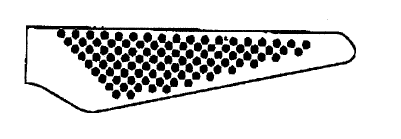Verwijzen naar producten in plaats van naar registratie
Gerecht EU 8 mei 2012, zaak T-331/10 (Yoshida Metal Industry/OHMI, gevoegd: Pi-Design en Bodum)
Gerecht EU 8 mei 2012, zaak T-416/10 (Yoshida Metal Industry/OHMI, gevoegd: Pi-Design en Bodum)
|
|
Twee soortgelijke zaken. Europees Gemeenschapsmerk. In een nietigheidsprocedure wordt van een beeldmerk dat een oppervlak bedekt met zwarte cirkels, de nietigheid gevorderd op basis van absolute weigeringsgronden. De nietigheidsafdeling wijst de vordering af, de kamer van beroep wijst nietigverklaring van het merk toe. Middel: Schending van 7(1)(b) en 7(1)(e-ii), deze vorm is nodig voor het behalen van een technisch resultaat.
De Kamer van beroep ging er, nu blijkt, ten onrechte van uit dat het merk deuken representeerde op een handvat van een mes en daarmee voor grip zorgde. Uit de registratie volgt niet dat er sprake is van holle deuken, maar van een patroon van afbeeldingen. Uit jurisprudentie en uit de eis van rechtszekerheid volgt dat slechts de gerepresenteerde vorm in de aanmelding voorwerp van beoordeling kan zijn. "the Board of Appeal did not refer to the sign as filed, but to representations of the goods actually marketed by the applicant." Daarom wordt de beslissing van de Kamer van Beroep vernietigd.
The character of the contested trade mark
29 It should be recalled that the Board of Appeal took the view that all of the black dots of the contested trade mark in fact represented dents and constituted a non-skid structure applied to the handle of a knife.
30 In this respect, it must be stated that the concave character of the black dots is not part of the contested trade mark as filed and registered. There is nothing in the graphic representation of the contested mark to suggest that the black dots in question represent dents rather than a figurative pattern. Likewise, the registration of the contested mark was not accompanied by any description to that effect. Therefore, in concluding that the dots were concave in character, the Board of Appeal did not refer to the sign as filed, but to representations of the goods actually marketed by the applicant.
35 Consequently, the Board of Appeal erred in departing from the graphic representation of the contested trade mark when it referred to representations of the goods actually marketed by the applicant in order to conclude that the black dots appearing in that trade mark were concave in character.

























































































